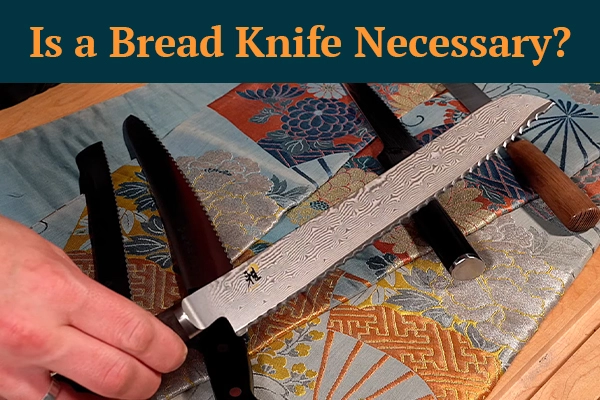Can a Kitchen Knife Cut Through Bone?
The knives we use for food preparation are kitchen knives. A kitchen knife is a very useful tool for a chef. It is used for everything from cutting meat to slicing fruits and vegetables. But can it also cut through bone?
“Cutting through a bone using a kitchen knife” is a very interesting question.
It’s not a “YES” or “NO” question.
The answer is, “It depends.”
It depends on many things like the length of the blade, the thickness of the spine, the size of the handle, the length of the tang, the weight of the knife, the grinding angle of the blade, etc.
For those who don’t know what a grinding angle is, a grinding angle or sharpening angle is the angle caused between the knife and the sharpening stone during sharpening.
Before jumping to the answer, you need to know what types of knives are in a kitchen and what they are used for.
Let’s dive into it.
Types of kitchen knives and their uses
There are more than ten types of kitchen knives. Each has its benefits and limits of uses. I am going to discuss the six most common types of them here.
Chef’s Knife

A chef’s knife is a general-purpose kitchen knife. It is also known as a cook’s knife. It is the most useful knife among all the kitchen knives. The length range of the chef’s knives’ blades is 6-14 inches. Generally, a chef’s knife has an 8-10 inch long and 1.5-inch wide blade.
You can use it for chopping, slicing, and dicing various foods. Almost all cutting tasks, from cutting chicken to slicing tomato, can be done with a chef’s knife.
A chef’s knife with a full-tang design is suitable for heavy cutting; however, a half-tang design is not. A forged one is heavier than a stamped one and also pricy. On the other hand, a forged knife generally comes with a full-tang handle and is fit for heavy work.
Meat Cleaver

Cleaver or meat cleaver is a rectangular shape, heavy and large knife. It comes with a full-tang handle with a thick spine. Sometimes it may have a curved blade or a straight one.
It has a 6-7 inch long blade in general. It is generally used for heavy cutting even through hard food such as meat, poultry even pumpkin. As it’s a heavyweight knife, it is fit for heavy chopping.
In addition, its thick spine helps you to generate more power during heavy cutting.
Butcher’s Knife

A butcher knife cuts or processes meat in a kitchen, restaurant, or BBQ camp. Mountain men widely used it in the 18th century.
It is pretty similar to a Cleaver knife. The blade of this knife is usually 6 to 8 inches long. It is thinner than a cleaver knife but thick enough to cut through the meat. Though it is designed for butchering, it is used for self-defense also.
Carving Knife

A carving knife is a very long knife from all other kitchen knives. It has an 8 to 15-inch blade. The blade is longer but thinner than a cleaver, butcher knife, or chef’s knife. It is mainly used to carve and slice cooked and smoked meat.
A carving knife is the best for cutting or slicing roasts, chickens, porks, lambs, and even portions of beef. Sometimes it is used to slice big fish. It is designed to cut a precise slice from any of the above.
Boning Knife

A boning knife is a knife with a narrow, thin, and short blade. Usually, the blade is 4 to 6 inches long. This small knife is a convenient tool for removing bone from meat and poultry.
However, as it is very small, it can get into a tinny piece of meat. It has a very sharp point. It allows you to cut deeply and make holes into the meat. It’s a dedicated knife to isolate bone from meat.
Utility Knife

A utility knife is a small knife with a 4 to 7 inches blade in the kitchen arena. But, it is generally a cutting tool with a small replaceable blade.
It is a small and slim version of a chef’s knife. It is a go-to knife. Whether you are a professional or a home cook, a piece of utility knife is a must for you.
From cutting vegs to slicing fruit and even meat, you can use it easily everywhere. It is very much handy for its small size. A utility knife is unique for the smaller and quicker cutting task.
Paring Knife

It is the smallest knife among all the kitchen knives. It has only a 2 to 4 inches blade. It is also a handy one like the utility knife. It is used in many small tasks, like fruit peeling, veg cutting, shrimp deveining, meat cutting, etc.
Fillet Knife

Fillet knives are flexible versions of boning knives. It has a narrow, thin, 5 to 9 inches long blade. It features a constantly narrow blade towards the tip.
They are used to fillet big fish and remove scales from fish. The blade is flexible but strong enough to take control when filleting fish or poultry.
Bread Knife

As it is named, the bread knife is for cutting bread and cake. Generally, it has a 7-10 inches long blade. Not like other kitchen knives, it has an edge like a saw.
The cutting process is the same as the saw, not pushing down through the bread or cake but rather frequently pushing forward and pulling backward.
What is a kitchen knife used for
Kitchen knives are sharp and have a lot of surface area. For this, they can easily cut through soft materials, such as skin or meat, but not so much when it comes to thicker or harder objects.
Here are the five most common uses of kitchen knives:
- Cutting vegetables.
- Slicing fruits and vegetables like tomato, cucumber, etc.
- Cutting and slicing meat, chicken, etc.
- Removing bone from meats and fishes and fileting fishes.
- Slicing and cutting bread and cake.
How can a kitchen knife cut through a bone
Kitchen knives are generally designed to cut vegetables, fruits, and meats, which are not very hard. Most kitchen knives have grinding angles between 10 to 20 degrees to make chopping easy and precise. It makes the knife very sharp but not too hard to cut through bone.
As we can see above, a few knives can cut heavy and complicated things like hard fruit or meat. Others can’t do it; you may break your knife’s edge if you try.
What’s the solution?
Okay, the solution is to have a long, thick, heavy-weight full-tang blade knife to cut through more complicated things like bone and cartilage. The blade must have a grinding angle near or more than 20 degrees. The more the sharpening angle is, the better for heavy cutting.
Knives with over 20 degrees sharpening angles are indeed more durable. But undoubtedly with lower cutting performances. But for its thicker edge, it will be able to cut hard, dense ingredients, like frozen meats, cartilages, and bones. It would be best if you put more pressure to cut hard things in these cases.
The meat cleaver and the butcher knife will allow you to cut through small and medium-sized bones. A cleaver knife comes with a full-tang handle, a thicker spine, and a long blade. These will help you to generate more power during cutting.
And a butcher knife also. As well as, the sharpening angle of these knives is near about 20 degrees meaning the edges are more durable. The edges won’t bend or break as a result of heavy load.
Make sure the quality materials and construction of these tools. On the other hand, you may snap the handle, the blade, or both. To cut bones, you must place the piece of meat on an entire solid cutting board. But, be careful always!
Though some chef’s knives can cut through some soft bones like chicken, the blade needs to be long, heavy-weight, and a full-tang handled. Half-tang model can be broken its handle during heavy cutting.
Which knives are usually used to cut through bone
Butcher knife and meat cleaver knife can.
As we discussed, most kitchen knives have a lower sharpening angle to cut more precisely. They are not the right choices for heavy cutting. Only the butcher knives and cleaver knives among the kitchen knives are dedicated blades for heavy cutting.
Here we pick the three best knives to make your cutting easy.
Kitchen knives can cut through bone, but doing so requires a sharp knife and good technique. Bone is denser than meat, so the blade must pierce it directly to do damage.
In addition, knife blades can easily slip off the tiny bones and cause injury. Please, be careful to avoid hurting yourself when cutting with a kitchen knife. Always use a sharp knife; keep your hands away from the blade.

![Can a Bread Knife Cut Meat? [Know How You Can]](https://www.primekitchener.com/wp-content/uploads/2023/01/can_a_bread_knife_cut_meat.jpg)




